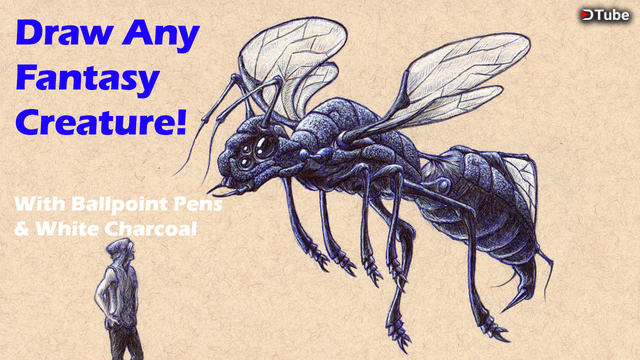
Time lapse video of a drawing of a giant wasp-like insect.
This video quickly demonstrates, visually, the step-by-step process I used to illustrate this fantasy creature, on 5.5" x 8.5" toned tan paper, with ballpoint pens and white charcoal.
This video was not originally created to be a tutorial, and unfortunately I did not take any progress shots/scans while drawing. However, if you follow the instructions below, and watch the video a few times for reference and to get an idea of the process that I used to draw this giant bee- or wasp-like insect, then I'm sure you can achieve a similar result!! :)
WHAT YOU NEED:
- Two different colors of ballpoint pen
- I recommend blue and black, but you can probably make this work with other colors as well
- You will use blue (or color of your choice) for the softer tones, and black (or darker color of your choice) for the shadows
- A white charcoal pencil
- This is for the highlights
- Toned/colored paper
- I used Strathmore toned tan paper for this, and I recommend it because if you leave some areas within your figure blank, the tan color is a nice mid-tone for your drawing
Note:
- Of course, you can use any paper/tool combination that you want, but the reason I chose these is because when you add white charcoal to a non-white paper, the highlights really pop off the page, adding a 3D feel to the end product. I also really like the ballpoint pen/white charcoal combination. Ballpoint pens, while permanent, are good for creating a "sketchy" or "pencil-like" feel to your drawings, and when you go over it with white charcoal, I personally think it blends really nicely!
PROCESS:
- SKETCH
Take the time to sketch out some ideas for your creature. I recommend drawing the sketches on a separate sheet of paper first. This will help you develop the idea, and it will also help visualize some of the important details, such as perspective, form, light source, etc. When you are ready, transfer or re-sketch the creature on the paper
- OUTLINE
This is one of the less important steps, but I like to outline the creature first, including all of the body parts. If you do use colored paper, you may want to consider doing this, because sometimes it can be hard to see the pencil sketch on toned paper. Keep in mind, that using a solid outline around every element of your drawing does not always look the most realistic (realistically, some edges may blend into the background) but I like to outline it to clearly define the shapes. And, personally, I really like the illustrative finish that it has.
- FIRST LAYER
Using the blue pen (or whatever color you chose), begin to fill in the outline. Refer to your initial sketches, keep in mind where your light source is, and focus on the values. Make the shadowed areas darker, and the areas where the highlights will be, keep your marks very light. For very bright areas, consider leaving it blank. Since you are using toned paper, you can allow some of it to show through as a mid-tone. (If you have ever painted, this step is like the underpainting, only some of it will show through on the final product)
Also focus on the textures. You can use fine cross-hatching if you want a smooth feel. Much of the texture in this drawing was created with erratic pen movements to achieve a rough looking texture for the "armored" exoskeleton.
- SHADOWS
Using your black pen (or darker color of your choice), darken the shadowed areas of your creature. Again, refer to your initial sketches to visualize where the shadows are. You can fade the black pen into the blue pen, allowing much of the blue pen near the mid-tones or highlights to show through, so that you have an even wider range of values.
Personal preference: I also like to re-outline everything with the black pen, but once again, if you are trying to achieve a more realistic result, this might not be the best idea.
- HIGHLIGHTS
White charcoal time!! Use your pencil to begin adding the highlights to the creature. I recommend beginning with the brightest areas. For narrow surfaces on the creature, a thin white line may be all you need. For wider surfaces, you can begin with a very white highlight and gradually fade it into the blue pen areas. The charcoal will really add some nice shape to your drawing!
- FINAL TOUCHES
At this point, I like to go over the entire drawing one more time with blue pen, correcting any areas where you added too much white charcoal, and maybe also with a black pen, if you feel that any shadows were ruined during the previous step.
IMPORTANT: Be careful not to drag your hand/fingers across the paper when touching it up...white charcoal smears/smudges very easily!
One final thought:
I think wings can be a little tricky to draw. If you don't get the perspective and foreshortening right, they just end up looking funky. Maybe go for something wingless ;)
And you're done!
I know this is not the most well-done tutorial. It definitely relies too much on the writing and not enough on the video. In the future, I hope to make more tutorial videos that actually take the time to visually and verbally step through the process slowly, in a more understandable way.
I hope you enjoyed it anyway. I would love any thoughts or suggestions on the video/"tutorial". Don't be shy!
▶️ DTube
▶️ IPFS
Great drawing, & amazing talent.
Thank you very much!